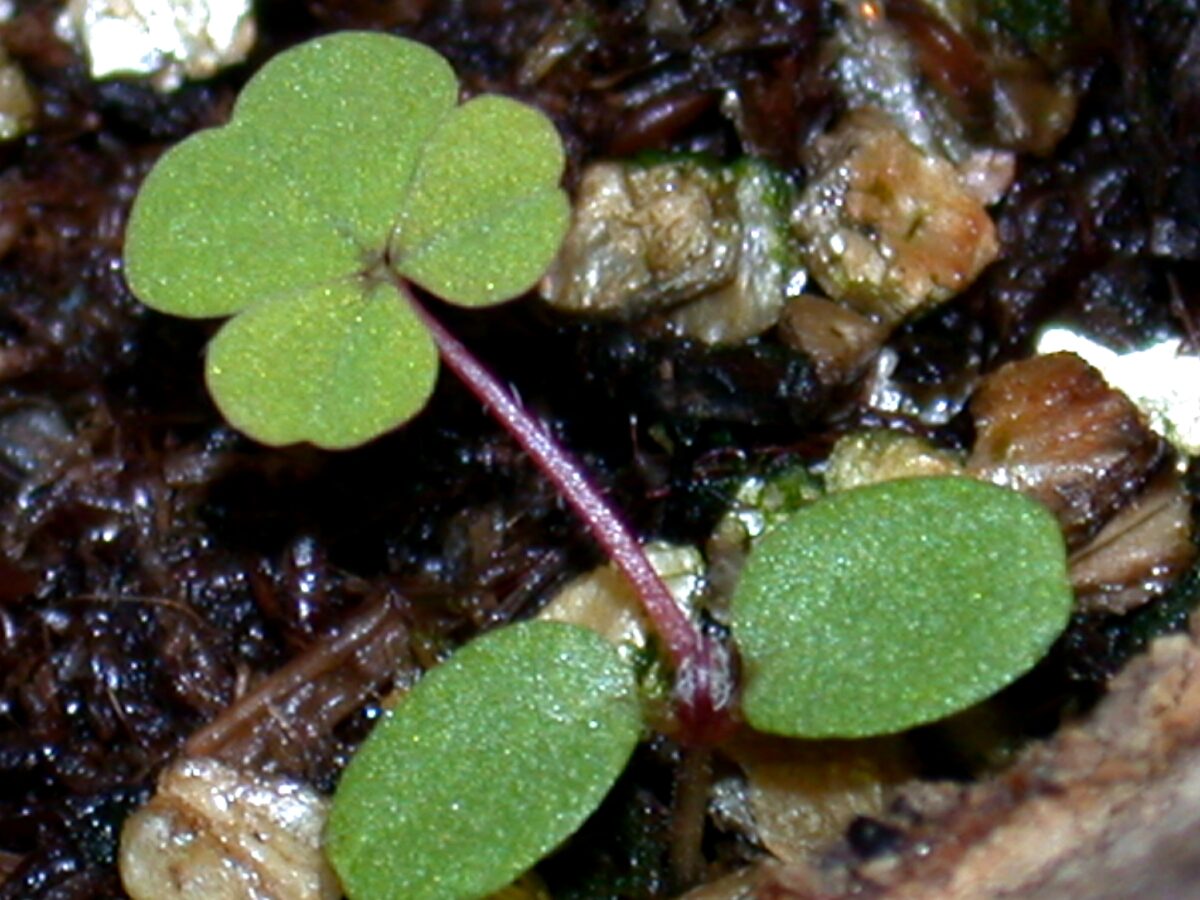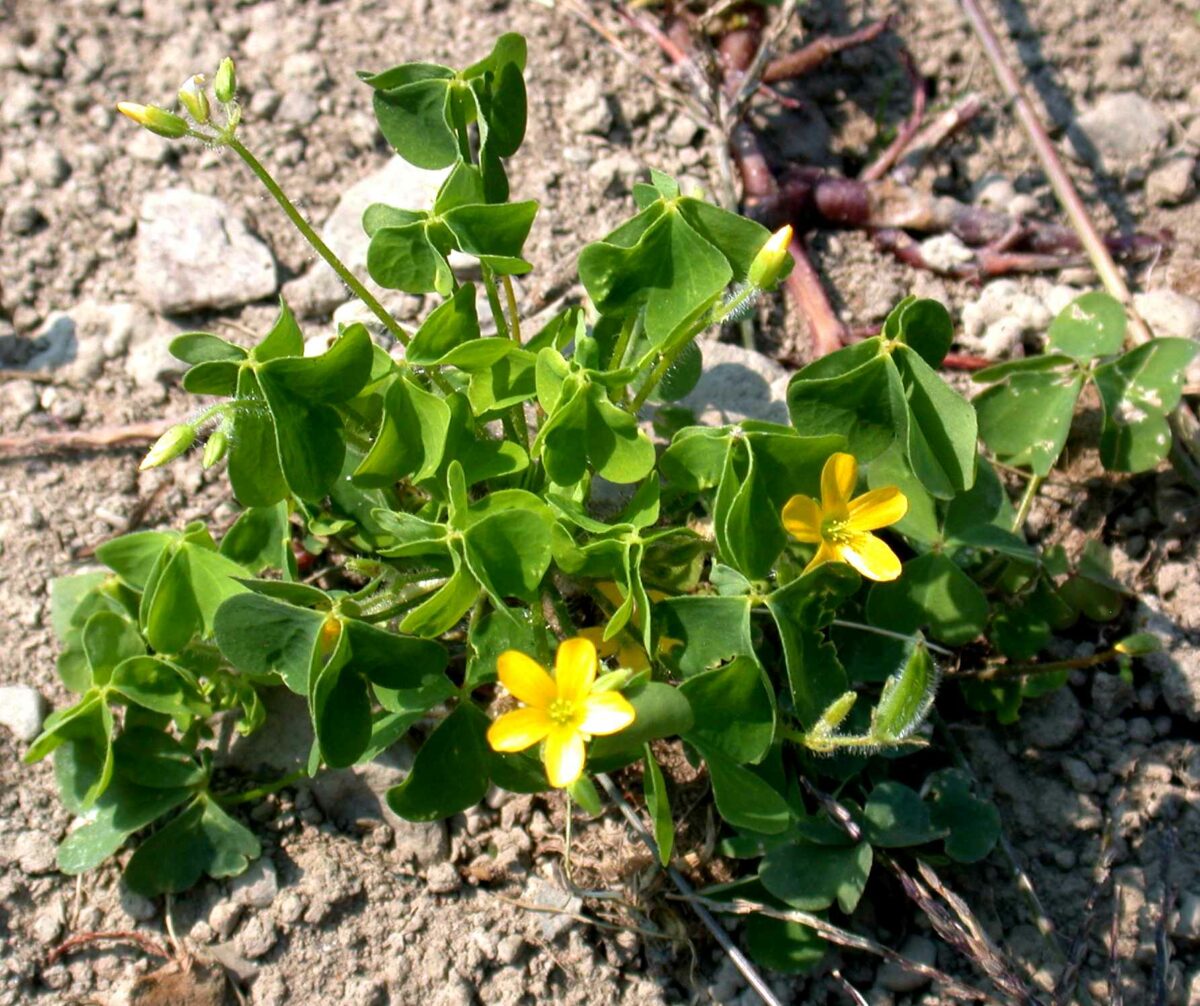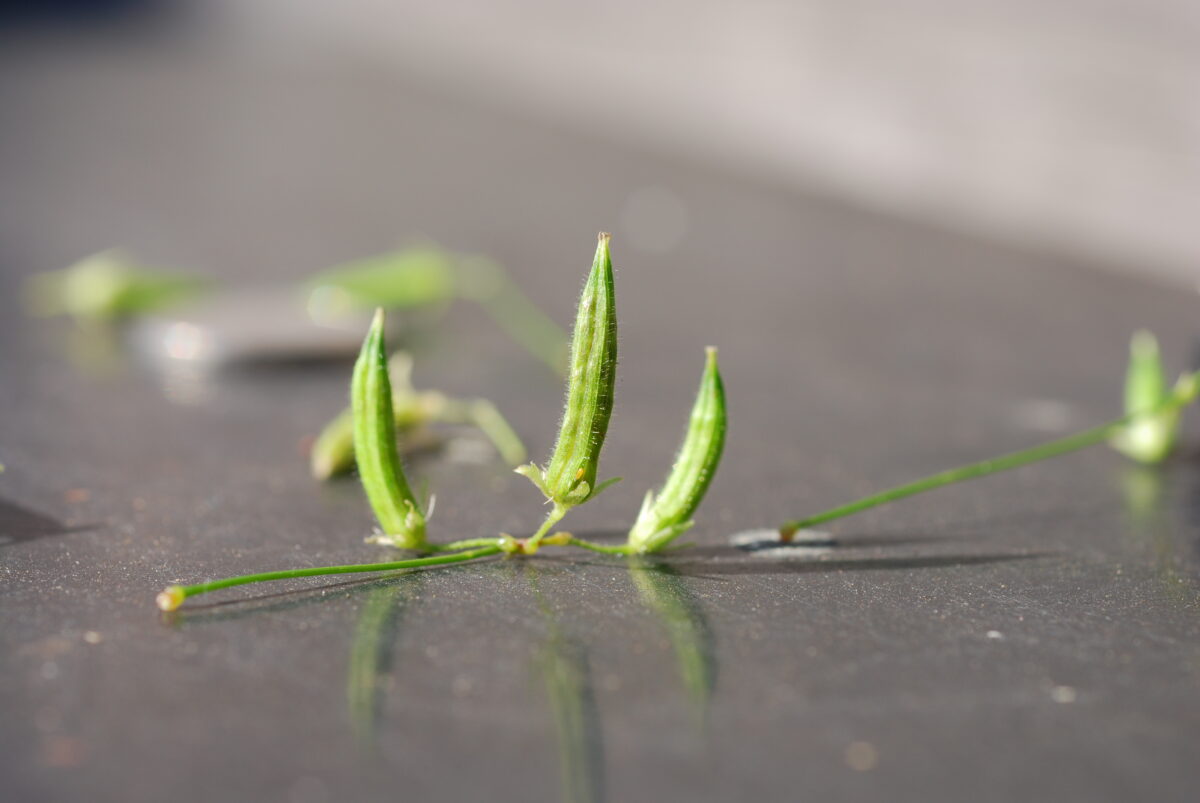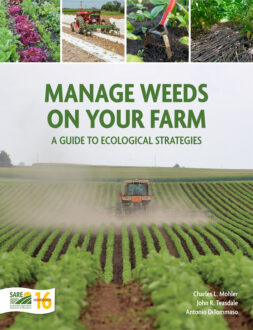


Oxalis stricta L.
Identification of Yellow Woodsorrel
Other common names: common yellow woodsorrel, common yellow oxalis, lady’s sorrel, lemon clover, sheep’s clover, sheep sorrel, sheep sour, sourgrass, tall wood sorrel, toad sorrel, upright wood sorrel
Family: Woodsorrel family, Oxalidaceae
Habit: Short, much branched perennial herb, commonly behaving as an annual in agricultural fields
Description: Cotyledons of the seedling are round to oblong, green to pinkish, hairless and 0.12–0.24 inch long by up to 0.2 inch wide. True leaves are alternate, green to occasionally purplish and are divided into three heart-shaped leaflets. Leaf edges are smooth. The leaflets are smooth on the upper surfaces and have short, scattered hairs on the lower surfaces and a fringe of hairs along the edges. Mature plants are 2–15 inches tall and unbranched or branching at the base. Stems are green to purplish and are covered in upward-facing, flattened hairs. Leaf shape and hairiness are similar to the seedling. Mature leaves are 0.5–1.1 inch wide, and individual leaflets are 0.25–0.5 inch wide and long. Leaf stalks are up to 2.5 inches long. The root system is fibrous, but the plant also produces shallow, spreading, white to pinkish rhizomes. Flowers grow in clusters of two to six from the leaf axils on stalks, which reach up to 1 inch long. The flowers are yellow, have five notched or rounded petals and five pale green sepals, and are 0.28–0.43 inch wide. Each flower is replaced by an upright, five-sided, pointed, cylindrical seedpod. The seedpods are hairy and 0.4–0.6 inch long. When ripe, the seedpods split and eject the seeds up to 6.5 feet from the plant. The seeds are flattened, red to brown, ridged transversely and 0.04–0.06 inch long.
Similar species: Creeping woodsorrel (Oxalis corniculata L.), a frequent weed in greenhouse and nursery culture, has a more prostrate, spreading habit than yellow woodsorrel and has aboveground runners rather than underground rhizomes. Slender yellow woodsorrel (Oxalis dillenii Jacq.) is very similar to yellow woodsorrel but is generally smaller and has a taproot rather than rhizomes. Clovers (Trifolium spp.), black medic (Medicago lupulina L.) and other trifoliate legumes have similar leaves to yellow woodsorrel. Legume leaflets are not heart shaped, however, and the leaves often have a pair of small bracts at the base of the stalk.
Management of Yellow Woodsorrel
Yellow woodsorrel is relatively non-competitive, but it is sufficiently prolific to make itself a problem in vegetable crops. Even when its density is too low to decrease yield, its rapid, upright growth causes harvest problems in herbs and leafy greens. In addition, it may serve as an alternative host to several diseases (Puccinia and Fusarium) of field and vegetable crops, including sweet corn and onions. Consequently, rotate these crops to other fields or beds until you have this species under control. This weed is most common in untilled crop fields, so tillage is an effective means of control. For dense infestations, flush the seeds out of the soil with repeated shallow cultivations before planting. Then plant competitive crops like snap beans or short season cabbage that can be repeatedly cultivated shallowly close to the row. Alternatively, grow an early crop like radish or head lettuce and use a tilled fallow during part of the summer. Avoid crops with long, post cultivation periods, as these will allow late emerging yellow woodsorrel to go to seed. Since this weed grows very fast, if you use a summer cover crop, plant it at high density to ensure good suppression. Hay or straw mulch and synthetic barrier mulches effectively suppress this weed. Hand weeding should be done before seed capsules form to prevent dispersal of seeds during the weeding process.
Ecology of Yellow Woodsorrel
Origin and distribution: Yellow woodsorrel is native to eastern North America and probably also eastern Asia. It has been introduced into western North America, Europe, Africa and New Zealand. It now occurs throughout most of the United States and southern Canada, except in the warmer parts of the Pacific coast and Intermountain West, where it is absent or occurs only sporadically.
Seed weight: Population mean seed weight ranges from 0.13–0.15 mg.
Dormancy and germination: Freshly produced seeds of yellow woodsorrel are not dormant and will germinate immediately if sown on warm, moist soil. Seeds germinate at 48–85°F, with optimum temperatures of 60–80°F. Exposure of moist seeds to a high temperature of 97°F will inhibit germination. Seeds require exposure to light after they have taken up water, with only a brief exposure to a low level of light being sufficient. Thus, seeds that get incorporated into the soil will normally wait to germinate until they are exposed to a pulse of light during tillage.
Seed longevity: In undisturbed conditions, seeds persist in the soil for at least five years and probably much longer. Seed viability was 83% after one year. Since the seeds germinate readily in recently disturbed soil, however, they are probably flushed out of the soil relatively quickly in regularly tilled and cultivated fields.
Season of emergence: In temperate climates, yellow woodsorrel emerges from mid-spring through summer. This species can emerge throughout the year in climates with warmer winters such as California.
Emergence depth: This has not been reported, but given the small seed weight, most seedlings probably arise primarily from the top 0.5 inch or less of soil. Sprouts from rhizomes could emerge from deeper in soil, however, unless buried, the rhizomes typically lie just below the soil surface.
Photosynthetic pathway: C3
Sensitivity to frost: Yellow woodsorrel tolerates light frost but dies back to the ground following hard frost.
Drought tolerance: The species tolerates dry spells of several weeks. Leaflets fold along a center crease in response to stress.
Response to fertility: Yellow woodsorrel tolerates low fertility but is most prolific in highly fertile soils. Plants respond to fertilizer application by producing a flush of new leaves and flowers.
Mycorrhiza: Yellow woodsorrel is mycorrhizal.
Soil physical requirements: Yellow woodsorrel grows on a wide range of soils but thrives in loamy soil. It is an indicator of moist, fertile soils but can tolerate drought-prone sites.
Response to shade: Yellow woodsorrel cannot grow in dense shade, but it tolerates the partial shade cast by many crops.
Sensitivity to disturbance: Plants can be easily uprooted by hand-weeding soon after emergence but can resprout from rhizomes after weeding or cultivation once they are established. The rhizomes lie just below the soil surface and are easily damaged, so resprouting is usually not a major problem. Plants will assume a prostrate growth habit in response to mowing.
Time from emergence to reproduction: Spring emerging plants flower four to six weeks after emergence and set seeds two to four weeks later. Plants emerging in midsummer can set seeds in as few as five weeks.
Pollination: Yellow woodsorrel is often self pollinated but is also cross pollinated by insects.
Reproduction: Yellow woodsorrel reproduces either by seeds and/or by perennating buds on rhizomes. Plants emerging from seeds in the spring and left undisturbed with minimal competition produced an average of 900 capsules each with an average of 23 seeds per capsule, thereby producing approximately 21,000 seeds per plant. Elsewhere, plants have been reported to produce 570–5,000 seeds per plant. Since newly produced seeds lack dormancy, the species can produce two complete generations per year in the northern United States and more in warmer climates. Vegetative reproduction by sprouts from rhizomes is rare in tilled fields but is common in less disturbed habitats.
Dispersal: The mature capsules rupture explosively, scattering seeds up to 13 feet. Seeds pass alive through ruminant digestive tracts and are spread with manure. Seeds may also be transported by rodents. They probably also move with soil on shoes, tires, machinery and by floating in waterways.
Common natural enemies: None of any consequence.
Palatability: Leaves or young plants of yellow woodsorrel are sometimes added to salads or cooked dishes to add a sharp, sour taste. The presence of the toxin oxalic acid, which accumulates in the aerial parts of the plant, gives the shoots their sour taste. Leaves have similar vitamin C content as that found in spinach and oranges.
Summary Table of Yellow Woodsorrel Characteristics
| Yellow Woodsorrel | ||||||||
|---|---|---|---|---|---|---|---|---|
| Growth habit | Perennial overwinter organ | Emergence period from perennial organs | Optimum emergence depth (inches) from perennial organs | Time/stage of lowest reserves | Photosynthesis type | Frost tolerance | Drought tolerance | Mycorrhiza |
| short, branched | rhizomes | mid-spring to summer | – | – | C3 | moderate | moderate | yes |
| Fertility Response | Importance of seeds to weediness | Seed weight (mg) | Dormancy of shed seeds | Factors breaking dormancy | Optimum temperarature range (F) for seed germination | Seedling emergence period | Emergence to flowering (weeks) | |
| moderate | high | 0.13–0.15 | no | li | 60–80 | mid-spring to summer | 4–6 | |
Table Key
Drought tolerance: Relative tolerance of aboveground plants to drought (high, moderate, low).
Emergence period from perennial organs: Time of year when most emergence occurs from perennial overwintering organs in the typical regions of occurrence for each weed. Some emergence may occur outside of this range.
Emergence to flowering: Length of time (weeks) after emergence from perennial organs to the beginning of flowering in the typical regions of occurrence. Note that this refers to established perennial plants, recognizing that some species may not flower in their initial year of establishment.
Factors breaking dormancy: The principle factors that are reported to break dormancy and facilitate germination. The order of listing does not imply order of importance. Abbreviations are:
- scd = seed coat deterioration
- cms = a period subjected to cold, moist conditions
- wst = warm soil temperature
- li = light
- at = alternating day-night temperatures
- ni = nitrates
Flowering to viable seed: Length of time (weeks) after flowering for seeds to become viable.
Frost tolerance: Relative tolerance of aboveground shoots to freezing temperatures (high, moderate, low).
General: The designation "-" signifies that data is not available or the category is not applicable.
Growth habit: A two-word description. The first word indicates relative height (tall, medium, short, prostrate) and the second word indicates degree of branching (erect, branching, vining).
Importance of seeds to weediness: The relative importance of seeds to dispersal, genetic diversity and survival of the species as a weed in agricultural environments (high, moderate, low).
Mycorrhiza: Presence of mycorrhizal fungi. “Yes” if present; “no” if documented not to be present, “unclear” if there are reports of both presence and absence; “variable” if the weed can function either with or without, depending on the soil environment.
Optimum emergence depth from perennial organs: Soil depths (in inches below the soil surface) from which most shoots emerge from perennial organs. Lower rates of emergence usually will occur at depths above or below this range.
Optimum temperature range for germination: Temperature (Fahrenheit) range that provides for optimum germination of non-dormant seeds. Germination at lower percentages can occur outside of this range. The dash refers to temperature range, and the slash refers to alternating day/night temperature amplitudes.
Perennial overwinter organ: Principal plant organ that survives winter and from which growth resumes in subsequent years.
Photosynthesis type: Codes “C3” or “C4” refer to the metabolic pathway for fixing carbon dioxide during photosynthesis. Generally, C3 plants function better in cooler seasons or environments and C4 plants function better in warmer seasons or environments.
Pollination: “Self” refers to species that exclusively self-pollinate; “cross” refers to species that exclusively cross-pollinate; “self, can cross” refer to species that primarily self-pollinate, but also cross-pollinate at a low rate; and “both” refers to species that both self-pollinate and cross pollinate at relatively similar rates.
Response to nutrients: Relative plant growth response to the nutrient content of soil, primarily N, P, K (high, moderate, low).
Seed dormancy at shedding: “Yes” if most seeds are dormant when shed; “Variable” if dormancy is highly variable; “No” if most seeds are not dormant.
Seed mortality in tilled soil: Range of mortality estimates (percentage of seed mortality in one year) for seeds in tilled soil. Values were chosen for seeds placed within the tillage depth and subjected to at least annual tillage events. Seed losses are the result of dormancy-breaking cues induced by tillage, germination and deterioration of un-germinated seeds.
Seed mortality in untilled soil: Range of mortality estimates (percentage of seed mortality in one year) for buried seeds in untilled soil. Values were chosen where possible for seeds placed at depths below the emergence depth for the species and left undisturbed until assessment. Mortality primarily represents seed deterioration in soil.
Seed weight: Range of reported values in units of “mg per seed."
Time/stage of lowest reserves: Time of year and/or weed growth stage at which carbohydrate reserves are lowest. This usually corresponds to the time when the weed is most susceptible to weed management operations.
Typical and high seed production potential: The first value is seed production (seeds per plant) under typical conditions with crop and weed competition. The second value, high seed production, refers to conditions of low density without crop competition. Numbers are rounded off to a magnitude that is representative of often highly variable reported values.
Typical emergence season: Time of year when most emergence occurs in the typical regions of occurrence for each weed. Some emergence may occur outside of this range.
Weed: Weed common name as listed in the Weed Science Society of America Composite List of Weeds, presented in alphabetical order.
Further Reading
Halverson, W.L. and P. Guertin. 2003. Factsheet for: Oxalis stricta L. USGS Weeds in the West project. 29 pp.
Lovett Doust, L., A. MacKinnon and J. Lovett Doust. 1985. Biology of Canadian weeds. 71. Oxalis stricta L., O. corniculata L., O. dillenii Jacq. ssp. dillenii and O. dillenii Jacq. ssp. filipes (Small) Eiten. Canadian Journal of Plant Science 65: 691–709.
Marshall, G. 1987. A review of the biology and control of selected weed species in the genus Oxalis: O. stricta L., O. latifolia H.B.K. and O. pes-caprae L. Crop Protection 6:355–364.

